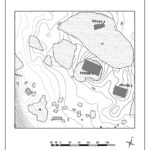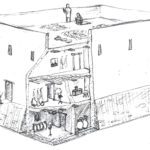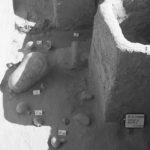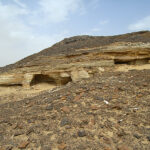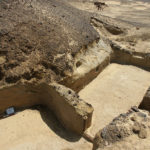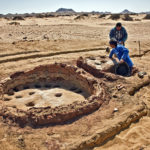BIʾR ŠAWĪŠ
| Arabic | بئر شويش |
| English | Bir Shawish | Bir Showish |
| DEChriM ID | 19 |
| Trismegistos GeoID | 15633 |
| Pleiades ID | - | PAThs ID | - |
| Ancient name | - |
| Modern name | Biʾr Šawīš |
| Latitude | 28.047450 |
| Longitude | 28.647433 |
| Date from | 1 |
| Date to | 500 |
| Typology | Village |
| Dating criteria | Pottery and coinage. An IFAO mission identified Roman and early Byzantine period ceramic – fragments of siga, LRA 7 and African amphorae (Africana IIC and IID) datable between the end of the 3rd century and the 5th century (Colin et al. 2010: 157). The team of the Czech Institute of Egyptology confirmed the first assessment made by S. Marchand during the survey of the IFAO team in 1999, bringing to light further amphoric material, such as fragments of Africana IIA and IIB. A possible rim of a Dressel 1 amphora situates the first occupation of the site in the 1st century AD, while a fragment of an amphora of the Keay 24A or Keay 31 types suggests that the site remained active in the 5th century (Musil, Tomášek 2009: 232, fig. 16; Musil et al. 2013: 34; Smoláriková, Kučová 2014: 154). In house 1, fragments of a Hayes 60 amphora and of African IIA and IIB amphorae have been dated in the 3rd-4th century (Musil et al. 2013: 35). However, another publication of the same team (Musil, Tomášek 2013: fig. 4.9, nos. 116-120) shows Hayes 93 et Hayes 67 types of amphorae, which are datable rather to the 5th century. House 2 and the surrounding ovens were associated with similar amphorae (Africana IIA, IIB, IIC). Together with other North African importations, these denote an occupation up to the 5th century, even beginning of the 6th. Houses 3 and 4 were only partly excavated. House 3 revealed coherent assemblages (Musil et al. 2013: 36-47). In contexts 2 and 6 of house 3 were found complete forms of amphorae of the types Hayes 59B, Hayes 59C, Hayes 67 and Hayes 91A (Musil et al. 2013: figs. 43-44), which hint at the first half of the 5th century. To the same period date a Spatheion and a LRA 4 amphora, both belonging to the same contexts (Smoláriková, Kučová 2014: 155, figs. 4-5). This horizon is confirmed by coins, the most recent of which were minted under Valentinian II (375-392) and Honorius (393-423), and an ostracon dated to 402/403 (Musil et al. 2013: 43). Room 19 contained a whole lot of table amphorae and cooking pots (Musil et al. 2013: figs. 45-46). However, room 7 seems to have revealed earlier African amphorae (Africana II Grande, Africana IIB, IIC) (Musil et al. 2013: 46). All this implies that house 3 had a longer occupation, which covered also the duration of use of the adjacent ovens. |
| Description | Situated in western part of the al-Ḥayz oasis (about 40km south of the al-Baḥariyya oasis), east of the modern village of Ġarbiyya, Biʾr Šawīš is an agricultural agglomeration suggested to have been occupied from the second half of the first century to the end of the fifth or early sixth centuries (Dospĕl: 2015: 19). Along with ʿAyn Rīs, Biʾr Šawīš is the only other site in al-Ḥayz that documents a Christian presence. Prehistoric occupation of the site has been recorded, followed by a Roman/Byzantine settlement, with no pharaonic/Ptolemaic or Medieval occupation having yet been identified (Dospĕl, and Suková 2013: 7). The Roman/Byzantine phase of the site is by far the most prevalent, with the state of preservation, and the extant of preservation, enabling an almost intact view into the location in antiquity, including settlements, agricultural fields, production facilities, roads, cemeteries, qanāt, and a cult installation (Dospĕl, and Suková 2013: 9; Musil, Tomášek, Kučová, and Šanderová 2013: 6). Considering the limited evidence of Prehistoric occupation, and the lack of a documented Pharaonic/Ptolemaic phase, it seems fair to say that permanent occupation of the site did not occur until the first or second century AD. The site consists of four distinct ‘houses’, interpreted as individual farmsteads connected by production facilities, including a number of pottery kilns, all of which was surrounded by fields, vineyards and palm orchards (Musil, Tomášek, Kučová, and Šanderová 2013: 30). A burial-cultic installation was identified in 2004, likely dating to the second or third century AD, but the work conducted was limited (Dospĕl and Suková 2013: 23). Likewise, a cemetery has been located on the eastern edge of the current desert, containing hundreds of graves (Musil, Tomášek, Kučová, and Šanderová 2013: 32). A complicated network of manāwir has been documented so far, totalling to some 20km (Dospĕl and Suková 2013: 23). To date, House number 3 is the most extensively excavated and well-documented sector of the site. House 1 House 2 House 3 The material from inside the house comprises an impressive amount of clearly datable material, which includes 68 coins. Of these coins, only 15 could be analysed with any degree of precision due to oxidisation. The approximate dates provided are from the last third of the third century to the last third of the fourth century and include coins of emperors Valentinian II (375-392AD), Theodosius I (379-395AD), Arcadius (384-408AD) and Honorius (393-423AD) (Musil, Tomášek, Kučová and Šanderová 2013: 43; Dospĕl 2015: 19). The remainder of the material from the house comes predominantly from the second half of the fourth to the first half of the early fifth century, with such a chronological concentration of material likely indicating a brief occupation, implying that the house was probably only operational for 2-3 generations (Musil, Tomášek, Kučová and Šanderová 2013: 47; Dospĕl 2015: 19). Additional material found in House 3 includes 104 clay vessels, 57 clay lamps, 19 bronze items, a clip, 3 rings, 2 bronze equal arm balances with plates, and a stylus (Musil, Tomášek, Kučová, and Šanderová 2013: 41). Among these finds are numerous Christian identifiers. This includes 66 ostraca fragments, coming from some 52 ostraca, which contain a number of unambiguously Christian names, as well as terms used in referring to a priest and seemingly also for a monastery (Musil, Tomášek, Kučová and Šanderová 2013: 43; Dospĕl 2015: 43, 106). These ostraca are not only significant in their documentation of a Christian presence, but also in that many include datable information, including one which specifically dates to August 4, 403 (excav. No. 30/BS/05 Dospĕl 2013: 92). Accompanying these ostraca are a number of ceramic objects, including jugs, jar stoppers and a bowl, which have depictions of crosses crosses (Dospĕl 2013: 100, 104 106-108). It is difficult to definitively identify all of these depictions of crosses as Christian signifiers, however, as transecting lines are a basic design motif (Dospĕl 2015: 122). House 4 |
| Archaeological research | Prior to the 1930s the only information on al-Ḥayz, a small oasis south of al-Baḥariyya, appeared in reports by individual travelers, such as Giovanni Battista Belzoni, Frédéric Cailliaud and John Gardner Wilkinson. One of the earliest cartographic works of the al-Ḥayz oasis was featured in the once classified publication designed for the German Generalstab des Heeres, published at the outset of the Second World War (Dospĕl and Suková 2013: 19). In 1938, Egyptian archaeologist Ahmed Fakhry was the first to conduct any sort of survey of the oasis, including excavating a number of sites, but not Biʾr Šawīš. Another Egyptian archaeologist, Fekri Hassan, also surveyed the general area of the oasis, but again, not Biʾr Šawīš specifically. In January 1977, Gérard Roquet recorded on behalf of the Institut français d’archéologie orientale (IFAO) the graffiti inscribed on the walls of the church at al-Rīs. The local inspectorate of the Supreme Council of Antiquities (SCA) conducted archaeological exploration in the 1990s at the nearby fort of al-Rīs (Dospĕl and Suková 2013: 19). Site specific archaeological research at Biʾr Šawīš, however, was not initiated until 2003, led by the Czech Institute of Egyptology as part of a project focused on the entirety of the al-Ḥayz oasis. The first surface survey of the site was conducted in 2003, and work continued for three successive seasons. In 2006, the project received funding from the Grant Agency of the Czech Republic (GAČR č. 404/06/0513) for another three years of research under the title “Research of the Egyptian Western Desert 2005-2008” (Dospĕl and Suková 2013: 19; Musil et. al. 2013: 6). After this, the survey obtained the support of the Grant Agency (GA UK 3920) with the title “Prospection of late Roman contexts in the Al-Hayz Oasis in the Egyptian Western Desert” managed by S. Kučová and J. Musil. Systematic research, including minor excavations occurred continually until 2012, when the previous surveys were followed up by the project of the Internal Research Plan (VVZ) of the Institute for Classical Archaeology and the Czech Institute of Egyptology of the Faculty of Arts, Charles University, led by J. Musil and M. Bárta (“Transformation of social structures of the late ancient society in the Egyptian Western Desert: 205901”). The overarching aim of all of these projects was geared towards creating a more accurate and detailed archaeological map of the oasis, which included numerous systematic surveys, and the re-surveying of areas examined by Ahmed Fakhry. Between 2003 and 2011, the exploration was directed by Miroslav Bárta. Since 2012, the research has been headed by Jiří Musil (Dospĕl and Suková 2013: 5). A number of study seasons have also been conducted, the last of which was in 2014. |
• Bárta, M., V. Brůna, V. Černý, J. Musil, J. Svoboda, and M. Verna. 2004a. “Průzkum oázy el-Hajez, oáza Baharíja (březen 2004).” Pražské Egyptologické Studie 3: 183-202 and plates xi-xv.
• Bárta, M., V. Brůna, V. Černý, J. Musil, J. Svoboda, and M. Verna. 2004b. “Report on the Survey and Trial Excavations of the Czech Institute of Egyptology, Carried in the Area of El-Hayez, Baharia Oasis (2nd Season, 6.3-31.3.2004).” Přehled výzkumů 45: 23-28.
• Colin, F., D. Laisney, and S. Marchand. 2010. “Qaret el-Toub: un fort romain et une nécropole pharaonique. Prospection archéologique dans l’oasis de Bahariya 1999.” Bulletin de l'Institut français d'archéologie orientale 100: 145-192.
• Dospěl, M. 2012. “New Texts from the al-Hayz Oasis, a Preliminary Report.” In Actes du 26e Congrès international de papyrologie (Genève, 16–21-août 2010), edited by P. Schubert, 193–198. Recherches et Rencontres 30. Geneva: Droz.
• Dospĕl, M. 2013. “Written, Inscribed and Some Decorated Material from Bir Shawish, El-Hayz Oasis.” In Bahariya Oasis. Recent Research into the Past of an Egyptian Oasis, edited by Marek Dospĕl and Lenka Suková. Prague: Charles University.
• Dospĕl, M. 2015. "Ostraka and Other Inscribed Material from Bir Shawish, Small Oasis." PhD Dissertation.
• Dospěl, M., & A. Kosinová. 2009. Report on the Season of 2009 (May 19–23). [Expedition report submitted to the SCA, unpublished.]
• Dospĕl, M and L. Suková. 2013. Bahariya Oasis. Recent Research into the Past of an Egyptian Oasis. Prague: Charles University.
• Fakhry, A. 1950. The Egyptian Deserts: Baḥariya Oasis. Vol. 2. Cairo: Government Press.
• Fakhry, A. 2003. Bahriyah and Farafra. Cairo & New York: AUC Press.
• Ghica, V. 2012. “Pour une histoire du Christianisme dans le désert occidental d’Égypte.” Journal des Savants 2: 189-280.
• Ghica, V. 2016. “Vecteurs de la christianisation de l’Egypte au IVe siècle à la lumière des sources archéologiques.” Acta XVI Congressus Internationalis Archaeologiae Christianae, Rome 22-28.9.2013, edited by O. Brandt and G. Castiglia, 199. Città del Vaticano: Pontificio Istituto di Archeologia Cristiana.
• Musil, J. and M. Tomášek. 2009. “Archeologický výzkum pozdně římského osídlení na lokalitě Bír Šovíš.” In Ostrovy zapomnění: El-Héz a české výzkumy v egyptské Západní, edited by M. Bárta, 217-248. Prague: Dokořán.
• Musil, J. and M. Tomášek. 2011. “Pozdně římská spona s cibulovitými knoflíky z Bír Šovíše (oáza El-Héz, Egypt).” Archeologie ve středních Čechách 15, 515-521.
• Musil, J., M. Tomášek, S. Kučová, and J. Šanderová. 2013. “Egyptian Western Desert in the Roman Period: Al Hayz – Bahariya; The Survey of Development of the Landscape and its Settlement.” Památky archeologické 104:5-58.
• Musil, J., and M. Tomášek. 2013. “Die Besiedlung in der Oase El-Hays in der Römerzeit Auswertung der Funde”, in Bahriya Oasis: Recent Research into the Past of an Egyptian Oasis, edited by M. Dospel and L. Suková, 63-89. Prague: Czech Institute of Egyptology.
• Smoláriková, K. and Kučová, S. 2014. “Roman Transport Amphorae from Bir Shawish, el-Hayez, Bahariya Oasis.” Bulletin de la céramique égyptienne 24: 153-159.
• Wagner, G. 1987. Les Oasis d’égypte à l’époque grecque, romaine et byzantine d’après les documents grecs: Recherches de papyrologie et d’épigraphie grecques. Cairo: Institut français d’archéologie orientale.


 Json data
Json data
